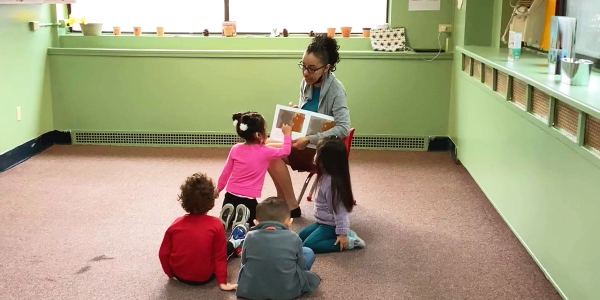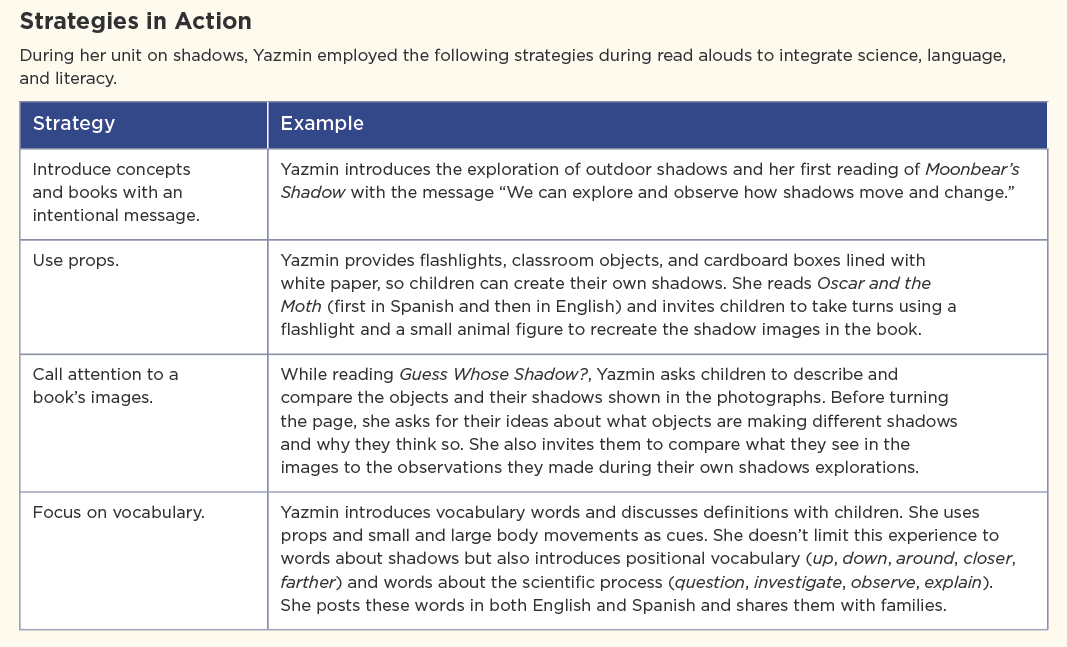Science and Literacy: Connecting Science, Language, and Literacy Through Books

You are here
During the first week of a three-week shadows study, children in Yazmin’s preschool class explore their shadows outdoors. Yazmin encourages them to observe how their shadows look, move, and change as they run and jump. During the week, she reads books with shadow themes, including Moonbear’s Shadow, by Frank Asch. As always, she supports knowledge of print by moving her finger from left to right under the text as she reads. But she also uses the book to draw out children’s observations, descriptions, and ideas about shadows.
“What do you notice about the size of Moonbear’s shadow in this picture?” she asks. “How did Moonbear’s shadow change? Why do you think it won’t go away when he asks it to?”
Over the next two weeks, Yazmin adds indoor explorations of shadows with flashlights, objects, and shadow puppets. She continues integrating books to support children’s science, language, and literacy learning simultaneously.
Science is a perfect vehicle for supporting children’s language and literacy development through books. Reading and discussing science-focused books support children’s speaking and listening skills, reading comprehension, and vocabulary development. As children read books on topics they’re actively exploring, they also have opportunities to do what scientists do: raise questions, plan explorations, gain new knowledge, and share their findings, observations, and thinking with others.
Our team at Education Development Center and the Connecticut Science Center partner with Yazmin (the second author) and other early childhood teachers in Connecticut to study strategies for supporting children’s language and literacy development through science. This integration of literacy across content areas is a key component of developmentally appropriate practice. Although our work focuses on children who are multilingual learners, we find that all children benefit when early childhood educators use books to support integration. Here, we offer strategies that you can use to incorporate books into a science unit and intentionally scaffold children’s science, language, and literacy learning.
Planning with Intention
Young children are born ready to wonder and explore as they look for the relationships and patterns that help them make sense of the world. Ongoing explorations of topics such as shadows, ramps, water, sound, colors, and living things excite and motivate them to talk, read, and write about their experiences, observations, ideas, and new learning.
Just like all teaching, planning for science and literacy integration must be intentional. It begins with thinking about the central concepts, or “big science ideas,” that will anchor and connect children’s direct explorations and book experiences. Two big ideas about shadows, for example, are that a shadow is created when an object blocks the light and that the shapes of shadows may change when the object or light source moves. (Knowing and choosing relevant “big science ideas” can be challenging; we’ve found resources like the PEEP and the Big Wide World educator site, which is free and available in English and Spanish, to be helpful.)
Next, decide which of the purposes for using books in science you will focus on. You might use them to create excitement about a topic of study, draw out children’s thinking related to the big ideas, help children make connections to their own experiences, and/or generate new ideas and questions for investigation. Finally, choose the direct experiences, books, and vocabulary that will be central to the unit and the sequence in which you’ll introduce them to support children’s science, language, and literacy learning.
Choosing Science-Focused Books to Support Language and Literacy Goals
Among other genres, children’s texts include storybooks, informational texts, and mixed-genre books, which have elements of both. You can use all of these to support a range of language and literacy goals, as outlined below.
Storybooks
In the opening vignette, Yazmin read the storybook Moonbear’s Shadow, about a bear who tries to escape from his shadow. During the reading, she supported children’s understanding of the word shadow and engaged them in thinking about the idea that shadows are created when an object blocks the path of light. As the shadows study progressed, Yazmin introduced children to another storybook with a character who is frightened by giant shadows: The Gruffalo’s Child, by Julia Donaldson. She used this book to nurture children’s growing understanding of shadows, their ability to share their ideas in group conversations, and their descriptive (bigger, smaller) and positional (in front of, behind, next to) vocabulary.
Informational Texts
We have found that books like these are best introduced once children have had some opportunities to explore a topic firsthand. When choosing informational books, look for texts you can use to support children’s thinking about their own observations and discoveries and to reinforce vocabulary related to the concepts they’re exploring in class. Help children interpret, evaluate, and make sense of the text and images in the book. These are key language and comprehension skills.
Yazmin supplemented her shadows study with Guess Whose Shadow?, by Stephen R. Swinburne, and Me and My Shadow, by Arthur Dorros. These books present concepts and vocabulary related to shadows at different levels of complexity. They also provide many opportunities for you to help children do what scientists do—raise questions, plan explorations, gain knowledge, and share their findings, observations, and thinking with others. Informational texts do not have to be read cover to cover to be effective. You can also use them as research references to look up answers to children’s specific questions.
Mixed-Genre Books
Mixed-genre books use fictional characters to communicate information. For example, in the English and Spanish versions of Oscar and the Moth: A Book About Light and Dark, by Geoff Waring, a wise moth teaches a curious kitten about where light comes from, how shadows are formed, and why it gets dark at night. In this book, the main character’s questions often reflect questions that children also wonder about, such as where does the sun go at night? The text models an ongoing conversation between the characters. In general, look for mixed-genre books that focus on phenomena children can experience and observe with their senses rather than concepts that they cannot experience directly.
Strategies for Reading Science-Focused Books with Children
To make the most of science-focused books, read alouds should be interactive and stimulate children’s observations and thinking about the science phenomena they’re exploring. Based on research—including our own work with preschool teachers—we recommend you use the following strategies to help build children’s emerging understanding of science concepts; their ability to ask questions, consider other perspectives, make inferences, and identify relationships; and their comprehension and vocabulary skills. (See “Strategies in Action” at the end of this article for examples of how Yazmin used these strategies in her shadows study.)
- Introduce explorations and books with an intentional message. An intentional message sets the stage for upcoming activities, ties children’s science and literacy experiences together, and supports comprehension and vocabulary learning. In our work, we use intentional messages beginning with the sentence stem “We can explore” to introduce related science explorations and book readings. This is an especially important strategy to use with multilingual learners because it clues them in to the upcoming activity and what to expect.
- Use props to bring the images and words in the book to life. Using concrete objects to demonstrate the actions and ideas described in the book supports children’s comprehension and vocabulary by helping them connect the information conveyed in the text to their own experiences, observations, and ideas. Inviting children to demonstrate or role-play as you read further supports these conceptual connections.
- Encourage children to closely observe and describe images in books. Talking with children about the images in a science-focused book helps them understand that images play a role in transmitting information. For example, focusing on photographs or scientifically accurate drawings in an informational text helps children interpret the images and understand that these graphics convey key information. When reading a storybook, you can help children evaluate the images for scientific accuracy by comparing them to what they’ve observed in their own explorations. These images can also be used to help children make inferences about how a character feels and behaves as they do and why.
- Focus on vocabulary words and their meanings. Identify a set of target vocabulary words that are responsive to your group’s current vocabulary levels, and use read alouds as opportunities to discuss and deepen children’s understanding of word meanings. Use a balance of science-related words (such as observe, describe, and compare) and rich, complex everyday words related to the topic. Try displaying words in both English and children’s home languages, and introduce more complex words as a science study progresses.
With intentional and thoughtful planning, you can connect children’s science, language, and literacy experiences, helping them to become knowledgeable thinkers, communicators, and readers. To get started, consider the following questions you might ask after a read aloud:
- What do you think the author was trying to tell us/teach us about?
- How was what we read similar to what we observed in our own explorations? How was it different?
- What did we read about that you would like to learn more about?
This work is supported by the National Science Foundation Grant DRL 1949266. Any opinions, findings, and conclusions or recommendations are those of the author(s) and do not necessarily reflect the views of the NSF.

Photograph: courtesy of the author
Copyright © 2024 by the National Association for the Education of Young Children. See permissions and reprints online at NAEYC.org/resources/permissions.
Cindy Hoisington is an early childhood and elementary science specialist and a project director at Education Development Center.
Yazmin Cólon Diaz is a preschool teacher at Hartford Neighborhood Center in Hartford, Connecticut.